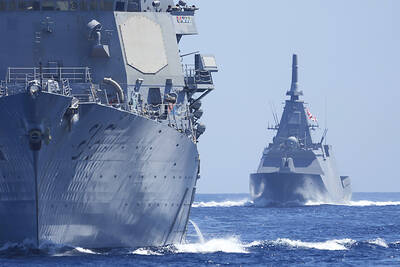Indian and Chinese leaders yesterday agreed to create a "strategic partnership for peace and prosperity" between the two Asian giants, sealing their agreement with a set of accords aimed at ending a long-standing border dispute and boosting bilateral trade and economic cooperation.
The statement announcing the partnership, signed by Chinese Premier Wen Jiabao (溫家寶) and his Indian counterpart, Manmohan Singh, said the agreement would promote diplomatic relations, economic ties and contribute to the two nations "jointly addressing global challenges and threats."
While the statement gave few details, it signaled a significant shift in relations between the neighbors, who together have one-third of the world's population, moving away from decades of mutual distrust and suspicion.
After a round of extended talks between Wen and Singh, the two sides announced their commitment to develop bilateral ties, saying relations have "acquired a global and strategic character."
"The leaders of the two countries have therefore agreed to establish an India-China strategic and cooperative partnership for peace and prosperity," the statement said.
The two countries also signed a raft of agreements for cooperation in such diverse areas as civil aviation, finance, education, science and technology, tourism and cultural exchanges.
"This is an important visit. We are working to promote friendly ties of cooperation between our two countries," Wen told reporters earlier yesterday after a ceremonial welcome by Singh at New Delhi's pink sandstone presidential palace.
"India and China can together reshape the world order," Singh said.
The two countries agreed on a framework to resolve their long-standing boundary dispute and outlined a set of broad parameters to demarcate the boundary through a "fair, reasonable and mutually acceptable solution, through equal and friendly consultations," the joint statement said.
"We want to put in place a bridge of friendship between our two countries," Wen said.
An 11-point roadmap to settle the decades-old border dispute between the two countries was finalized on Sunday at a meeting between National Security Adviser M.K. Narayanan and China's Vice Foreign Minister Dai Bingguo (
India and China share a mountainous, 4,000km border, parts of which are not demarcated. The two sides went to war over the border disagreement in 1962.
The roadmap states that the countries would take into consideration historical factors, geographical features, people living in the area, security and whether the area was currently under Indian or Chinese control when marking the border.
Yesterday, the two leaders agreed to boost bilateral trade to US$20 billion by 2008. Last year, trade totaled US$13.6 billion, with India recording a trade surplus of US$1.75 billion, according data available with India's trade ministry.
During their talks, Wen and Singh agreed to set up a panel of experts to study the feasibility and benefits of a free-trade area.

A fire caused by a burst gas pipe yesterday spread to several homes and sent a fireball soaring into the sky outside Malaysia’s largest city, injuring more than 100 people. The towering inferno near a gas station in Putra Heights outside Kuala Lumpur was visible for kilometers and lasted for several hours. It happened during a public holiday as Muslims, who are the majority in Malaysia, celebrate the second day of Eid al-Fitr. National oil company Petronas said the fire started at one of its gas pipelines at 8:10am and the affected pipeline was later isolated. Disaster management officials said shutting the

US Vice President J.D. Vance on Friday accused Denmark of not having done enough to protect Greenland, when he visited the strategically placed and resource-rich Danish territory coveted by US President Donald Trump. Vance made his comment during a trip to the Pituffik Space Base in northwestern Greenland, a visit viewed by Copenhagen and Nuuk as a provocation. “Our message to Denmark is very simple: You have not done a good job by the people of Greenland,” Vance told a news conference. “You have under-invested in the people of Greenland, and you have under-invested in the security architecture of this

UNREST: The authorities in Turkey arrested 13 Turkish journalists in five days, deported a BBC correspondent and on Thursday arrested a reporter from Sweden Waving flags and chanting slogans, many hundreds of thousands of anti-government demonstrators on Saturday rallied in Istanbul, Turkey, in defence of democracy after the arrest of Istanbul Mayor Ekrem Imamoglu which sparked Turkey’s worst street unrest in more than a decade. Under a cloudless blue sky, vast crowds gathered in Maltepe on the Asian side of Turkey’s biggest city on the eve of the Eid al-Fitr celebration which started yesterday, marking the end of Ramadan. Ozgur Ozel, chairman of the main opposition Republican People’s Party (CHP), which organized the rally, said there were 2.2 million people in the crowd, but

JOINT EFFORTS: The three countries have been strengthening an alliance and pressing efforts to bolster deterrence against Beijing’s assertiveness in the South China Sea The US, Japan and the Philippines on Friday staged joint naval drills to boost crisis readiness off a disputed South China Sea shoal as a Chinese military ship kept watch from a distance. The Chinese frigate attempted to get closer to the waters, where the warships and aircraft from the three allied countries were undertaking maneuvers off the Scarborough Shoal — also known as Huangyan Island (黃岩島) and claimed by Taiwan and China — in an unsettling moment but it was warned by a Philippine frigate by radio and kept away. “There was a time when they attempted to maneuver